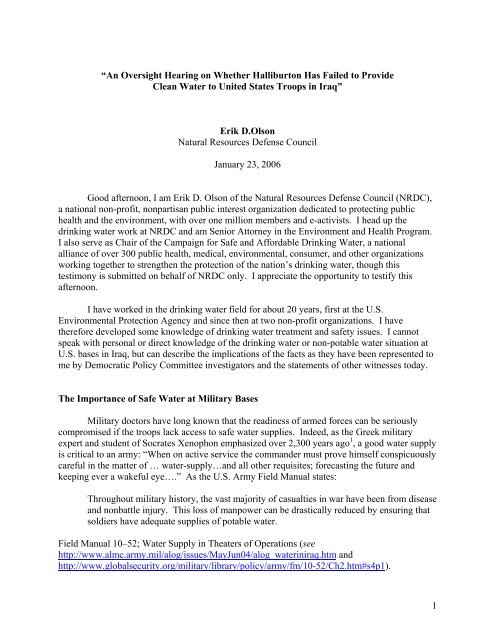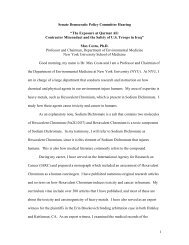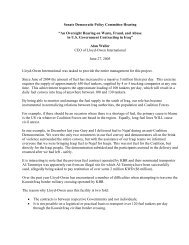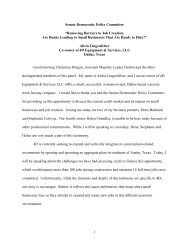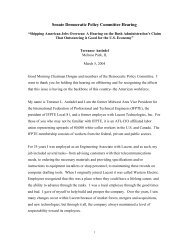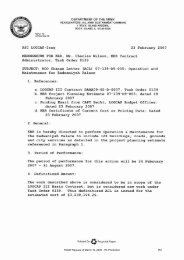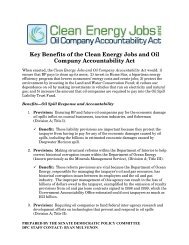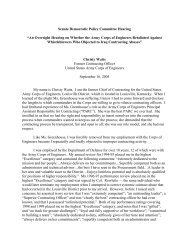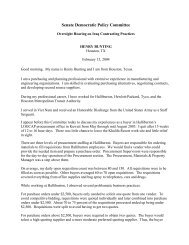Erik D. Olson - Halliburton Watch
Erik D. Olson - Halliburton Watch
Erik D. Olson - Halliburton Watch
You also want an ePaper? Increase the reach of your titles
YUMPU automatically turns print PDFs into web optimized ePapers that Google loves.
“An Oversight Hearing on Whether <strong>Halliburton</strong> Has Failed to Provide<br />
Clean Water to United States Troops in Iraq”<br />
<strong>Erik</strong> D.<strong>Olson</strong><br />
Natural Resources Defense Council<br />
January 23, 2006<br />
Good afternoon, I am <strong>Erik</strong> D. <strong>Olson</strong> of the Natural Resources Defense Council (NRDC),<br />
a national non-profit, nonpartisan public interest organization dedicated to protecting public<br />
health and the environment, with over one million members and e-activists. I head up the<br />
drinking water work at NRDC and am Senior Attorney in the Environment and Health Program.<br />
I also serve as Chair of the Campaign for Safe and Affordable Drinking Water, a national<br />
alliance of over 300 public health, medical, environmental, consumer, and other organizations<br />
working together to strengthen the protection of the nation’s drinking water, though this<br />
testimony is submitted on behalf of NRDC only. I appreciate the opportunity to testify this<br />
afternoon.<br />
I have worked in the drinking water field for about 20 years, first at the U.S.<br />
Environmental Protection Agency and since then at two non-profit organizations. I have<br />
therefore developed some knowledge of drinking water treatment and safety issues. I cannot<br />
speak with personal or direct knowledge of the drinking water or non-potable water situation at<br />
U.S. bases in Iraq, but can describe the implications of the facts as they have been represented to<br />
me by Democratic Policy Committee investigators and the statements of other witnesses today.<br />
The Importance of Safe Water at Military Bases<br />
Military doctors have long known that the readiness of armed forces can be seriously<br />
compromised if the troops lack access to safe water supplies. Indeed, as the Greek military<br />
expert and student of Socrates Xenophon emphasized over 2,300 years ago 1 , a good water supply<br />
is critical to an army: “When on active service the commander must prove himself conspicuously<br />
careful in the matter of … water-supply…and all other requisites; forecasting the future and<br />
keeping ever a wakeful eye….” As the U.S. Army Field Manual states:<br />
Throughout military history, the vast majority of casualties in war have been from disease<br />
and nonbattle injury. This loss of manpower can be drastically reduced by ensuring that<br />
soldiers have adequate supplies of potable water.<br />
Field Manual 10–52; Water Supply in Theaters of Operations (see<br />
http://www.almc.army.mil/alog/issues/MayJun04/alog_wateriniraq.htm and<br />
http://www.globalsecurity.org/military/library/policy/army/fm/10-52/Ch2.htm#s4p1).<br />
1
The U.S. Army and other armed forces recognize that not only the water that is provided<br />
as drinking water must be treated to be safe, but also water that is used by the troops and support<br />
for brushing teeth and even for showering must be adequately protected. According to military<br />
regulations and the Field Manual, the types of water and its uses are:<br />
Potable<br />
Uses for Potable and Nonpotable Water 2<br />
• Drinking<br />
• Heat treatment (cold water<br />
and ice for troops)<br />
• Personal hygiene (shaving, and cleaning of<br />
equipment daily sponge washing, brushing<br />
teeth)<br />
• Food preparation<br />
• Medical staff and equipment<br />
cleaning<br />
• Hospital medical treatment<br />
Nonpotable<br />
Why “Non-Potable” (including Shower) Water Needs to be Safe<br />
• Centralized hygiene (showering)<br />
• Laundering<br />
• Preparation of human remains<br />
• Nuclear, biological, and chemical<br />
decontamination of equipment<br />
• Vehicle maintenance<br />
• Aircraft washing<br />
• Engineer construction<br />
Military regulations recognize that shower water must be chlorinated and treated to some<br />
extent to assure safety, and, as noted above, water used for personal hygiene is required to be<br />
“potable.” While non-potable water is primarily not intended for human consumption, as anyone<br />
who has ever showered knows, small amounts of water often are inhaled as aerosol or swallowed<br />
during showering. Indeed, scientific investigations have shown that waterborne disease can be<br />
transmitted simply through inhaling aerosolized contaminated shower water. 3 The Centers for<br />
Disease Control and Prevention (CDC) published a report showing that in the U.S., even an<br />
“interactive fountain” that sprayed chlorinated water into the air at a water park caused a<br />
waterborne disease outbreak of Shigella and Cryptosporidium. 4 Scientific studies have shown<br />
that for some infectious organisms like Cryptosporidium only a sip of water—indeed just a few<br />
microscopic oocysts — can make you sick. 5 Thus, water that is used for showering and for tooth<br />
brushing, and certainly even for small sips of water to take pills for example, should not be<br />
contaminated with microorganisms that can cause waterborne illness.<br />
How Non-Potable Water is Reportedly Derived and Treated at Some U.S. Bases in Iraq<br />
According to some reports, raw water is taken from the Euphrates River at a point less<br />
than two miles downstream of a human sewage discharge point. There are likely to be other<br />
human and animal fecal discharges and runoff into this major river. If this is correct, like many<br />
rivers in the United States and around the world that receive runoff and sewage discharges, the<br />
2
aw water from the Euphrates is likely to be contaminated by a variety of disease-causing<br />
organisms, ranging from total coliform, E. coli and other bacteria, to viruses and hardy protozoa<br />
like Giardia and Cryptosprodium. These disease-causing organisms can cause a wide variety of<br />
symptoms, including diarrhea, nausea, vomiting, headaches, fever, lightheadedness, and in the<br />
event of serious infections can sometimes cause kidney failure and even death.<br />
According the information provided to us, while the potable drinking water at the U.S.<br />
B4 Ar Ramadi base in Iraq is either bottled water or is treated appropriately, the so-called nonpotable<br />
water used for showering (and apparently in some cases for hygiene such as brushing<br />
teeth) is the concentrated reject water from water treatment which reportedly is sometimes or<br />
often un-disinfected and unfiltered, and therefore is likely to be unsanitary.<br />
Specifically, it has been reported that military contractors charged with supplying water<br />
at B4 Ar Ramadi base in Iraq have been taking water from the Euphrates River, and filtering it<br />
and using a Reverse Osmosis Water Purification Unit (ROWPU). They reportedly have been<br />
using the treated water for potable drinking water, but using the reject waste water or<br />
“concentrate” from the ROWPU for non-potable water. Clearly, such water should at a<br />
minimum always be chlorinated to reduce the levels of bacteria and viruses. But it should be<br />
pointed out that even if this water is chlorinated, some chlorine-resistant disease-causing<br />
microbes like Cryptosporidium would not be killed by chlorine alone, and could still cause<br />
illnesses if present in the water. 6 This is a potentially dangerous situation for anyone who uses<br />
the non-potable water for showering or hygiene such as brushing teeth.<br />
Schematic of Reverse Osmosis Treatment Unit<br />
3
As the schematic above shows, an RO filter’s semi-permeable membrane works like an<br />
extremely fine screen, straining even very small contaminants, including bacteria, viruses, and<br />
oocysts such as Cryptosporidium out of the raw water. It concentrates the contaminants in the<br />
waste water, and produces clean “finished water” intended for human consumption. The waste<br />
water often has several times higher concentration of contaminants than the raw water — it is<br />
more polluted than the raw untreated water. This waste water should not be used for any human<br />
use such as showering or for human hygiene uses like tooth brushing.<br />
It has been reported that at B4 Ar Ramadi and perhaps some other U.S. bases in Iraq,<br />
some sinks in bathrooms that are used to brush teeth, to take medications, and perhaps to take a<br />
quick sip of water, that are supposed to have “potable water” may be plumbed to supply nonpotable<br />
water. If this is accurate, this water too could put users at risk of waterborne illness.<br />
Finally, it is worth noting that while NRDC certainly does not have sufficient information<br />
to claim that waterborne disease has been caused by this issue, we are aware that soldiers are<br />
often evacuated out of Iraq for non-combat related illnesses. The Association of Military<br />
Surgeons found that 9.1 percent of soldiers evacuated in 2003 suffered from problems of the<br />
digestive system; another 6.4 percent had nervous system disorders; 6.1% suffered urological<br />
problems; and 8.3 percent suffered from unknown illnesses. 7 It is known from published<br />
literature before the war that Cryposporidium and other waterborne disease have been a problem<br />
in Iraq, 8 and U.S. military assessments have indicated that there are threats in Iraq from<br />
waterborne parasites such as Cryposporidium and Giardia. 9<br />
Conclusion<br />
If reports are accurate that water used for showering and potentially for hygiene uses such<br />
as tooth brushing at some U.S. bases in Iraq is not properly treated, and sometimes actually the<br />
concentrated contaminated reject water from Reverse Osmosis treatment units that use Euphrates<br />
River water as their raw water source, this would present substantial public health concerns for<br />
personnel using this water. We urge that this practice be ceased and that proper water treatment<br />
be initiated immediately for all such uses.<br />
NOTES<br />
1 Xenophan, “The Calvary General,” Section VI, translation available at http://www.sonshi.com/xenophon6.html<br />
2 First Lieutenant Jarred Wm. Guthrie, “Obtaining and Purifying Water in Iraq,” (2004), available online at<br />
http://www.almc.army.mil/alog/issues/MayJun04/alog_wateriniraq.htm.<br />
3 See, for example, K. Nygard et al., “Waterborne outbreak of gastroenteritis in a religious summer camp in<br />
Norway,” Epidemiology & Infection, 2004 Apr; 132(2):223-9.<br />
4 P. Minshew et al., “Outbreak of Gastroenteritis Associated With an Interactive Water Fountain at a Beachside Park<br />
--- Florida, 1999,” Morbidity & Mortality Weekly Report, 49(25);565-8, June 30, 2000, available online at<br />
www.cdc.gov/mmwr/preview/mmwrhtml/mm4925a3.htm<br />
5 Messner MJ, Chappell CL, Okhuysen PC, “Risk assessment for Cryptosporidium: a hierarchical Bayesian analysis<br />
of human dose response data,” Water Res. 2001 Nov;35(16):3934-40<br />
6 CDC, “Cryptosporidium Infection Cryptosporidiosis: Fact Sheet,” (2005), available online at<br />
http://www.cdc.gov/ncidod/dpd/parasites/cryptosporidiosis/factsht_cryptosporidiosis.htm<br />
7 D.R. Harman et al., “Aeromedical Evacuations from Operation Iraqi Freedom: A Descriptive Study,” Military<br />
Medicine (June 2005), available online at www.findarticles.com/p/articles/mi_qa3912/is_200506/ai_n13644581; see<br />
4
also “Whistleblowers’ Stomach Curdling Story: <strong>Halliburton</strong> Serves Contaminated Water to Troops, available online<br />
at www.halliburtonwatch.org/news/contamination.html<br />
8<br />
Nadham K. Mahdi, Imad A. Al-Sadoon and Adel T. Mohamed, “First report of cryptosporidiosis among Iraqi<br />
children,” Eastern Mediterranean Health Journal Volume 2, Issue 1, 1996, Page 115-120, available online at<br />
www.emro.who.int/Publications/EMHJ/0201/16.htm<br />
9<br />
Interestingly, a U.S. military routine report noting these diseases is available online in Google’s cache at<br />
http://72.14.203.104/search?q=cache:RIIlyFZS-<br />
8sJ:www.gulflink.osd.mil/declassdocs/dia/19950825/950825_84429041.html+euphrates+cryptosporidium&hl=en<br />
but apparently has been removed from the military website at which it originally appeared.<br />
5


